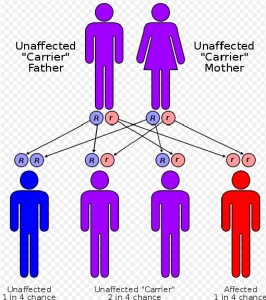Canavan Disease is one of the most common chronic cerebral disorders that affect humans who are in their infancy. Read on to know all about the causes, symptoms, diagnosis and treatment of this syndrome.
Page Contents
- 1 What Is Canavan Disease?
- 2 Canavan Disease History
- 3 Canavan Disease Symptoms
- 4 Canavan Disease Causes
- 5 How Is Canavan Disease Inherited?
- 6 Canavan Disease Diagnosis
- 7 Canavan Disease Treatment
- 8 Canavan Disease Prognosis
- 9 Canavan Disease Complications
- 10 Canavan Disease Prevention
- 11 Canavan Disease Prevalence
- 12 Canavan Disease Pictures
This is a disorder that is inherited by an offspring from his or her parent. The disease has an impact on the use and collapse of Aspartic Acid. The condition is also known by other names like Aspartoacylase Deficiency, Aminoacylase 2 deficiency, Canavan-Van Bogaert-Bertrand disease and Spongy degeneration of the brain.
It belongs to a group of genetic conditions known as Leukodystrophies.
Picture 1 – Canavan Disease
Source – wikimedia
The condition was first reported by Myrtelle Canavan in 1931. However, it was not until 1997 that the Miami Children’s Hospital made a patent of the gene causing this condition and began to claim royalties on testing the gene.
The symptoms of this condition generally arise as early as in the first year of the life of a person. The disorder impedes the development of a child that includes control of the head. It leads to progressive deterioration of the nerve cells located in the brain.
Some of the main symptoms of the disease are
- Swallowing difficulties
- Poor visual tailing or blindness
- Nasal regurgitation or backflowing of food particles into the nose
- Macrocephaly or enlargement of head size
- Feeding problems
- Irritability
- Head lag or lack of control in head when a baby is pulled to a sitting posture from a lying position
- Lack of muscle tone, particularly in the neck
- Reflux along with vomiting
- Acute mental retardation
Heredity is supposed to be the main causative factor for this condition as evident by the presence of this disease in several generations of a family. The gene that acts as a carrier of this disorder can be found in human chromosome 17.
The disease is also thought to result from a lack of the enzyme known as Aspartoacylase. A deficiency of Aspartoacylase enzyme results in an accumulation of a substance in the brain known as N-acetylaspartic acid. This leads to a breakdown of the white matter present in the brain.
The condition is inherited from one or both parents who are carriers if this genetic defect. The defect passes on from parents to offspring and becomes apparent after birth. If the gene is inherited from both parents, the chance of getting this condition becomes higher.
The diagnosis of this condition requires Prenatal Tests such as Blood Tests and Genetic Tests. Genetic Counseling is suggested to patients who have both parents as carriers of these mutated genes. In some cases, DNA Testing may be carried out in infants. Doctors carry out this examination if they suspect that there is Canavan Disease infection in the fetus.
In infants, Post Natal Diagnostic Examinations such as blood test, genetic testing and medical imaging are carried out. The NAA levels are also measured by testing the Amniotic fluids. A normal prenatal blood test helps in screening missing enzymes or genetic mutations that control Aspartoacylase. It thus helps in identifying Canavan Disease.
Some other diagnostic tests performed for this disorder are
- MRI Scan of the head
- CT Scan of the head
- Genetic examination for mutation of Aspartoacylase gene
- Urine Chemistry
- Blood Chemistry
Tests also help reveal presence of symptoms like Joint stiffness, Optic Atrophy or loss of tissues in the optic nerve located in the eye and Hyperreflexia or Amplified Reflexes.
There is no specific cure for this condition. The aim of treatment is to control the symptoms arising from this disorder. Symptomatic cure is mainly supportive and involves methods like Gene Therapy in which neuronal stem cells are inserted into the brain of the suffering infant to aid in the production of the Aspartoacylase enzyme.
The prognosis for this condition is usually poor. This is more due to lack of effective treatment than any other reason. Most infants affected by this condition die before they are 4 years old. In many cases, death occurs before patients turn 18 years of age. In rare cases however, kids may survive until they are in their teens or about twenty years of age. Occupational and Physical Therapies such as massages and motor training movement improvement are also used for curing patients who are suffering from this disease.
This is a life-threatening condition that gives rise to acute disabilities like
- Mental Retardation
- Lack of ability to walk
- Blindness
As stated before, the condition causes early death of a person. In most cases, suffering individuals die even before they are in their teenage years.
This condition can be prevented if couples undergo DNA Testing before birth of an infant. DNA Testing helps reveal if one or both parents are carriers of the gene of this syndrome. The condition is very common in parents who are of Ashkenazi Jewish origin. Parents of this descent should undergo Genetic Counseling. There is 25% chance of having an infant suffering from Ashkenazi when the gene carrying the disease is present in both parents.
People with Canavan Disease may belong to any ethnic group. But the condition is seen more in individuals belonging to Eastern European Jewish (Ashkenazi) descent. About one in every 40 individuals of Ashkenazi Jew community is seen as a carrier of this syndrome.
Here are some useful pictures of Canavan Disease that will give you an idea about how individuals suffering from the condition look like.
Picture 2 – Canavan Disease Picture
Source – images.picturesdepot.com
Picture 3 – Canavan Disease Image
Source – drugster.info
Canavan Disease is a condition with poor prognosis. However, diagnosing this condition earlier may help in curing it by making up for the lack of Aspartoacylase enzyme with the aid of neuronal stem cell introduction. If you find your child or any infant in your family showing poor development or mental retardation, it may be a sign of abnormalities of this condition. You must get in touch with an expert healthcare in such cases. Early cure may help make an early recovery and prevent further complications.
References:
https://health.google.com/health/ref/Canavan+disease
http://en.wikipedia.org/wiki/Canavan_disease
http://www.medicinenet.com/canavan_disease/article.htm
http://www.ninds.nih.gov/disorders/canavan/canavan.htm



